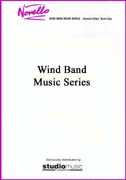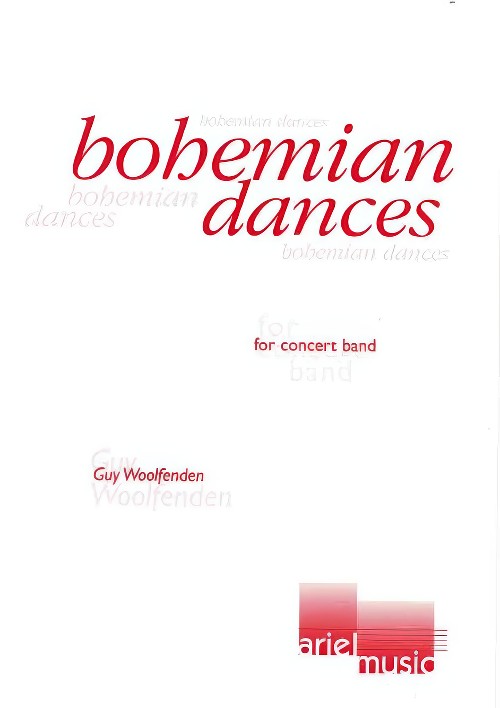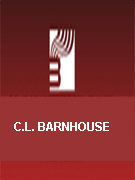Results
-
 £164.95
£164.95BIG SKY COUNTRY (Novello Symphonic) - Wiggins, Bram
Score & Parts. Big Sky Country was the prize-winning work of the Worshipful Company of Musicians' Competition for a new wind band piece, 1984. This suite for Military Band depicts different aspects of Canada: The Mighty St. Lawrence; Quiet Lakes and Distant Hills; Stampede.
Estimated dispatch 7-14 working days
-
 £32.95
£32.95BIG SKY COUNTRY (Novello Symphonic) Extra Score - Wiggins, Bram
Extra score only. Big Sky Country was the prize-winning work of the Worshipful Company of Musicians' Competition for a new wind band piece, 1984. This suite for Military Band depicts different aspects of Canada: The Mighty St. Lawrence; Quiet Lakes and Distant Hills; Stampede.
Estimated dispatch 7-14 working days
-
 £115.00
£115.00BOHEMIAN DANCES (Concert Band) - Woolfenden, Guy
Includes:1. Shepherds and Shepherdesses2. Florizel and Perdita3. Dance of the SatyrsOne of my favourite Shakespeare plays is The Winter's Tale, and I have written music for three completely different productions during my time as Head of Music to the Royal Shakespeare Company. One, starring Judi Dench as both the mother, Hermione and her daughter, Perdita, had a big band Tribal Love-Rock score; another had a more classical, but timeless feel to it, and the last was an excellent small-scale touring production, for which I was allowed only a handful of instruments. It is from this source that the basic themes for Bohemian Dances, and an earlier version Three Dances for Clarinet Choir, have emerged. Act IV of the play is set in the kingdom of Bohemia - hence the title of the work.Shakespeare calls for "A Dance of Shepherds and Shepherdesses", which gives Florizel, the son of Polixenes, (King of Bohemia) a chance to become better acquainted with the beautiful Perdita, the lost daughter of Leontes, (King of Sicilia). This movement is written in seemingly tricky and ever-changing metres, but is rhythmically quite logical and melodically catchy.The slower second movement 'Florizel and Perdita' is the lovers' pas de deux: a gentle, slow waltz-like tune, initially presented by the principal oboe, is contrasted with a lndler-like double time melody, at the end of which a solo clarinet makes a link to the last movement.'Dance of the Satyrs' is a rip-roaring, foot-stamping dance performed in the play by 'three carters, three shepherds, three neat-herds, and three swine-herds', who enter in outrageous costumes representing the lecherous half-man, half-goat of Greek mythology. This dance is referred to as a "gallimaufry of gambols" - now where have I heard that word before?! - GW
Estimated dispatch 7-14 working days
-
 £179.99
£179.99Brasserie (Brass Quintet with Concert Band - Score and Parts) - Schwarz, Otto M.
This work was conceived by Otto M. Schwarz as a piece that progresses through different styles in a manner similar to his Concerto Grosso.Thematic material is introduced by a quintet and then taken over by the band, and vice versa. Brasserie is one of the very few works of its type.Duration: 9:45
Estimated dispatch 7-14 working days
-
 £44.55
£44.55Bravada (Concert Band - Score and Parts)
This processional march will be a perfect addition on many different programs. Solidly scored for younger players, it's characterized by a strong, tuneful melody and bold rhythms. Following a dramatic modulation, this stirring march leads to a glorious finale!
Estimated dispatch 7-14 working days
-
 £84.99
£84.99Bread and Games Wind Band Set (Score & Parts)
Panem et Circenses', Bread and Games were essential for keeping the citizens of ancient Rome in check. While the bread was meant for the poorest among the Romans, the Games were Popular Pastime Number One for everybody.There were different kinds of games, such as chariot races (especially popular with female spectators), or wild-beast fights, where lions, tigers, bulls or bears were set on one another or even on human beings. Most popular, however, were the Gladiator fights. In 'Bread and Games' William Vean depicts one of the many fights in the antique Colosseum. 1. Entrance of the Gladiators: By powerful bugle-calls the attention of the people was asked for, after which the Gladiators entered the Arena at the sound of heroic marching-music.2.Swordfight: We can hear that the fights were not mere child's play in this part.On the contrary, they were a matter of life and death and were fought accordingly.3.Mercy of the Emperor: Sometimes a wounded gladiator could be fortunate, depending on the mercy of the audience. Waving one's handkerchief meant mercy, a turned-down thumb meant no pardon. The Emperor had the right to take the final decision, but he usually complied with the wish of the majority of the public. 4.Lap of Honour: Gladiators were mainly selected among slaves, convicted criminals, or prisoners of war. Consequently, winning was very important, as it would mean fame, honour and sometimes even wealth. A lap of honour, therefore, was the winner's due reward. 06:00
Estimated dispatch 7-14 working days
-
 £289.99
£289.99Bulgarian Dances (part II) (Concert Band - Score and Parts)
Bulgarian folk music has a long tradition and numerous typical characteristics, such as particular dissonances and complex, irregular rhythms. In Bulgarian Dances (Part II) (which can be performed together with the previously published title Bulgarian Dances) Franco Cesarini has preserved the original spirit of Bulgarian folk music, yet has imbued it with a symphonic character and brought it into the concert hall. The three different movements give us a meditative, moving folksong and a lively dance, before a distinctly symphonic part leads to a glittering finale. 18:15
Estimated dispatch 7-14 working days
-
 £49.50
£49.50Cedar Creek Sketches
An exciting overture that begins with a slow lyrical introduction before leading into a very rhythmic and energetic allegro section. The slow melodic middle section contains an optional trumpet solo. Cued throughout to allow for different musical colors and it offers the stability that less experienced players need. This effective composition provides a welcome opportunity for all instruments to experience playing the melody. Excellent for building confidence in young or inexperienced groups while providing a delightful concert or contest selection. Exceptional teaching material.
Estimated dispatch 7-14 working days
-
 £154.99
£154.99Chansons Bachiques Wind Band Set (Score & Parts)
In this four-movement suite, every moment sings of a different type of French wine. All these wines have their origins in the little French village of Savigny-les-Beaune in Burgundy and are made by wine-grower Pierre Guillemot. It was the excellent quality of the wines that inspired Rob Goorhuis into writing this composition. The first three movements deal with three red wines made of the Pinot Noir grape which all bear the Premier Cru designation. The final movement was inspired by a white wine made of Pinot Blanc and Chardonnay. In the nature of their musical material, the various movements not only give a characterisation of the taste of the wines. they also hint at impressions of the respective vineyards and their surroundings. 1st Movement Les Narbantons - Giocoso 2nd Movement Les Jarrons - Gracioso 3rd Movement Les Serpentieres - Festivo 4rd Movement Dessus des Golardes - Vivaci. 13:00
Estimated dispatch 7-14 working days
-
 £49.50
£49.50Chorale Variations (Concert Band - Score and Parts)
You can let out all the stops with this delightful selection that swings from start to finish. This march incorporates several different musical styles including cut-time "quick step" style, straight-ahead swing and dixieland. A Guaranteed audience favorite!
Estimated dispatch 7-14 working days
